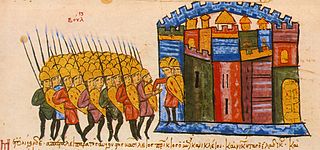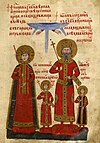
The Cyrillic script, Slavonic script or simply Slavic script is a writing system used for various languages across Eurasia. It is the designated national script in various Slavic, Turkic, Mongolic, Uralic, Caucasian and Iranic-speaking countries in Southeastern Europe, Eastern Europe, the Caucasus, Central Asia, North Asia, and East Asia, and used by many other minority languages.

The Glagolitic script is the oldest known Slavic alphabet. It is generally agreed that it was created in the 9th century for the purpose of translating liturgical texts into Old Church Slavonic by Saint Cyril, a monk from Thessalonica. He and his brother Saint Methodius were sent by the Byzantine Emperor Michael III in 863 to Great Moravia to spread Christianity there. After the deaths of Cyril and Methodius, their disciples were expelled and they moved to the First Bulgarian Empire instead. The Cyrillic alphabet, which developed gradually in the Preslav Literary School by Greek alphabet scribes who incorporated some Glagolitic letters, gradually replaced Glagolitic in that region. Glagolitic remained in use alongside Latin in the Kingdom of Croatia and alongside Cyrillic until the 14th century in the Second Bulgarian Empire and the Serbian Empire, and later mainly for cryptographic purposes.

Cyril and Methodius were brothers, Byzantine Christian theologians and missionaries. For their work evangelizing the Slavs, they are known as the "Apostles to the Slavs".
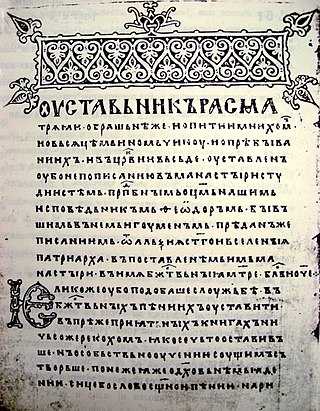
Old Church Slavonic or Old Slavonic is the first Slavic literary language.

Boris I, venerated as Saint Boris I (Mihail) the Baptizer, was the ruler (knyaz) of the First Bulgarian Empire in 852–889. The historian Steven Runciman called him one of the greatest persons in history. Despite a number of military setbacks, the reign of Boris I was marked with significant events that shaped Bulgarian and European history. With the Christianization of Bulgaria in 864, paganism was abolished. A skillful diplomat, Boris I successfully exploited the conflict between the Patriarchate of Constantinople and the Papacy to secure an autocephalous Bulgarian Church, thus dealing with the nobility's concerns about Byzantine interference in Bulgaria's internal affairs.

The Early Cyrillic alphabet, also called classical Cyrillic or paleo-Cyrillic, is an alphabetic writing system that was developed in Medieval Bulgaria in the Preslav Literary School during the late 9th century. It is used to write the Church Slavonic language, and was historically used for its ancestor, Old Church Slavonic. It was also used for other languages, but between the 18th and 20th centuries was mostly replaced by the modern Cyrillic script, which is used for some Slavic languages, and for East European and Asian languages that have experienced a great amount of Russian cultural influence.

Church Slavonic, also known as Church Slavic, New Church Slavonic, New Church Slavic or just Slavonic, is the conservative Slavic liturgical language used by the Eastern Orthodox Church in Belarus, Bulgaria, North Macedonia, Montenegro, Poland, Ukraine, Russia, Serbia, the Czech Republic and Slovakia, Slovenia and Croatia. The language appears also in the services of the Russian Orthodox Church Outside of Russia, the American Carpatho-Russian Orthodox Diocese, and occasionally in the services of the Orthodox Church in America.

The Bulgarian Cyrillic alphabet is used to write the Bulgarian language. The Cyrillic alphabet was originally developed in the First Bulgarian Empire during the 9th – 10th century AD at the Preslav Literary School.

Naum (Bulgarian and Macedonian: Свети Наум, Sveti Naum, also known as Naum of Ohrid or Naum of Preslav, was a medieval Bulgarian writer and missionary among the Slavs, considered one of the Seven Apostles of the First Bulgarian Empire. He was among the disciples of Cyril and Methodius and is associated with the creation of the Glagolitic and Cyrillic script. Naum was among the founders of the Pliska Literary School. Afterwards Naum worked at the Ohrid Literary School. He was among the first saints declared by the Bulgarian Orthodox Church after its foundation in the 9th century. The mission of Naum played significant role by transformation of the local Early Slavs into Bulgarians.

The Preslav Literary School, also known as the '''Pliska Literary School''' or '''Pliska-Preslav Literary school''' was the first literary school in the medieval First Bulgarian Empire. It was established by Boris I in 886 in Bulgaria's capital, Pliska. In 893, Simeon I moved the seat of the school from the First Bulgarian capital Pliska to the new capital, Veliki Preslav. Preslav was captured and burnt by the Byzantine Emperor John I Tzimisces in 972 in the aftermath of Sviatoslav's invasion of Bulgaria.
Chernorizets Hrabar was a Bulgarian monk, scholar and writer who worked at the Preslav Literary School in the First Bulgarian Empire at the end of the 9th and the beginning of the 10th century. He is credited as the author of On the Letters.

The First Bulgarian Empire was a medieval state that existed in Southeastern Europe between the 7th and 11th centuries AD. It was founded in 680–681 after part of the Bulgars, led by Asparuh, moved south to the northeastern Balkans. There they secured Byzantine recognition of their right to settle south of the Danube by defeating – possibly with the help of local South Slavic tribes – the Byzantine army led by Constantine IV. During the 9th and 10th century, Bulgaria at the height of its power spread from the Danube Bend to the Black Sea and from the Dnieper River to the Adriatic Sea and became an important power in the region competing with the Byzantine Empire.

The Church of Saints Clement and Panteleimon is a Byzantine church situated on Plaošnik in Ohrid, North Macedonia. It is attributed to Saint Clement of Ohrid, a disciple of Saint Cyril and Saint Methodius. Archaeologists have come to believe that the church is located on the site where the first students of the Glagolitic alphabet were taught in the First Bulgarian Empire.
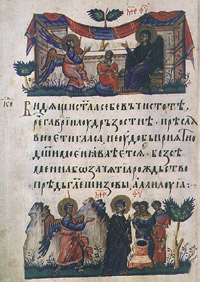
Medieval Bulgarian literature is Bulgarian literature in the Middle Ages.

Kutmichevitsa was an administrative region of the Bulgarian Empire during 9th-11th cent., corresponding roughly with the northwestern part of the modern region of Macedonia and the southern part of Albania, broadly taken to be the area included in the triangle Saloniki-Skopje-Vlora. It had an important impact on the formation, endorsement and development of the Old Church Slavonic and culture. The Debar–Velich diocese of the Bulgarian Orthodox Church was created in Kutmichevitsa whose first bishop between 886 and 893 was Clement of Ohrid, appointed by Knyaz Boris I.
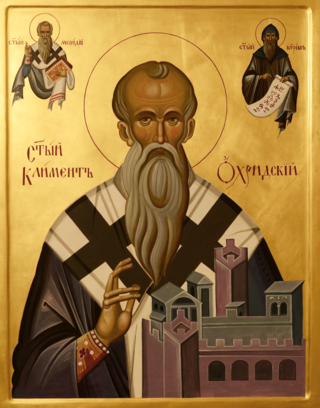
Clement or Kliment of Ohrid was one of the first medieval Bulgarian saints, scholar, writer, and apostle to the Slavs. He was one of the most prominent disciples of Cyril and Methodius and is often associated with the creation of the Glagolitic and Cyrillic scripts, especially their popularisation among Christianised Slavs. He was the founder of the Ohrid Literary School and is regarded as a patron of education and language by some Slavic people. He is considered to be the first bishop of the Bulgarian Orthodox Church, one of the Seven Apostles of Bulgarian Orthodox Church since the 10th century, and one of the premier saints of modern Bulgaria. The mission of Clement was the crucial factor which transformed the Slavs in then Kutmichevitsa into Bulgarians. Clement is also the patron saint of North Macedonia, the city of Ohrid and the Macedonian Orthodox Church.
This is a list of people, places, and events related to the medieval Bulgarian Empires — the First Bulgarian Empire (681–1018), and the Second Bulgarian Empire (1185–1396).

The Golden Age of Bulgaria is the period of the Bulgarian cultural prosperity during the reign of emperor Simeon I the Great (889—927). The term was coined by Spiridon Palauzov in the mid 19th century. During this period there was an increase of literature, writing, arts, architecture and liturgical reforms.

The Seven Apostles are seven saints venerated in the Bulgarian Orthodox Church since the 10th century.



















